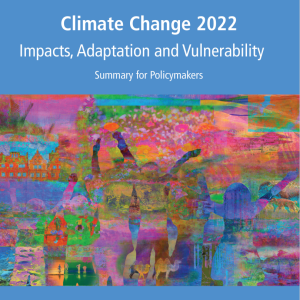
This report from the Intergovernmental Panel on Climate Change (IPCC) reviews the evidence on climate change’s impacts on ecosystems, biodiversity and people. It finds that there is a greater than 50% chance that global warming will reach or exceed 1.5°C (above the 1850-1900 baseline) in the near term, even under very low emissions scenarios, and that human-induced climate change has already caused “widespread adverse impacts” for nature and for people.
The observed changes in the world’s climate include more frequent and more intense heat on land and in the ocean, heavy precipitation, drought, and weather that enables fires. Impacts on people and nature include increased heat-related deaths, warm-water coral bleaching and death, tree deaths related to drought, greater areas burned by wildfires in some regions, increased negative effects from tropical cyclones, and slow-onset processes such as ocean acidification, sea level rise and regional decreases in precipitation.
The report finds that climate change is causing substantial damages, some irreversible, to terrestrial, freshwater, coastal and open ocean marine ecosystems. These include widespread deterioration in ecosystem structure and function, shifts in seasonal timing, shifts in species towards poles or higher elevations, mass mortality events on land and at sea, and loss of kelp forests. Irreversible damages include some species extinctions, while changes approaching the point of irreversibility include hydrological changes caused by glacial retreat, and changes in some mountain and Arctic ecosystems caused by permafrost thawing.
TABLE readers may be particularly interested in the following points relating to food and agriculture:
- Climate change has slowed the growth in overall agricultural productivity, having negative impacts mainly in mid and low latitudes, and positive impacts in some high latitude areas. Some ocean areas have seen adverse impacts on food production because of ocean warming and acidification. Increasing extreme weather events have exposed millions of people to acute food insecurity, particularly in Africa, Asia, Central and South America, Small Islands and the Arctic. (Source: section SPM.B.1.3 of the Summary for Policymakers)
- While agricultural development can contribute to food security, the expansion of agricultural land in unsustainable ways leads to greater ecosystem and human vulnerability and leads to competition for land and water. The report notes that agricultural expansion is driven partly by unbalanced diets, and defines balanced diets as those featuring plant-based foods (e.g. coarse grains, legumes, fruits, vegetables, nuts and seeds) and animal-sourced foods produced in “resilient, sustainable and low-greenhouse gas emissions systems”. (Source: section SPM.B.2.3)
- Climate change will put increasing pressure on food production and access in vulnerable regions through increases in the frequency, intensity and severity of droughts, floods and heatwaves. At 2°C or more, food security risks will be more severe, particularly in Sub-Saharan Africa, South Asia, Central and South America, and Small Islands; soil health and ecosystems services such as pollination would be increasingly weakened by warming; and marine animal biomass will reduce. More areas will be exposed to climate risks at 3°C than at 2°C, exacerbating regional differences in food security. (Source: section SPM.B.4.3)
- Above 1.5°C of warming, the risk of simultaneous maize crop failures increases. Other risks that could interact with each other to negatively impact food security include heat and drought, heat-induced labour productivity losses, contamination of food through mycotoxins, and contamination of seafood by algal blooms. (Source: section SPM.B.5.1)
- Movement of fish caused by climate change may increase the risk of cross-boundary management conflicts. (Source: section SPM.B.5.3)
- Using large areas of land for climate mitigation can increase risks to food security if not done carefully, e.g. poorly implemented bioenergy or ecologically inappropriate afforestation. (Source: Section SPM.B.5.4)
- The report identifies options for protecting food security in sustainable ways, including: agroforestry; farm diversification; urban agriculture; agroecological principles; ecosystem-based management of fisheries; and reducing food loss and waste. (Source: section SPM.C.2.2)
- Chapter 5 of the full report (note: this is a large PDF that is slow to load) is about “Food, fibre and other ecosystem products”.
For another summary of the report, see this piece by Carbon Brief: In-depth Q&A: The IPCC's sixth assessment on how climate change impacts the world.
Read the full report, Climate Change 2022: Impacts, Adaptation and Vulnerability, here. See also the TABLE explainer Impacts of climatic and environmental change on food systems.







Post a new comment »